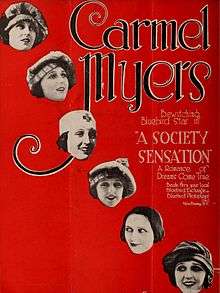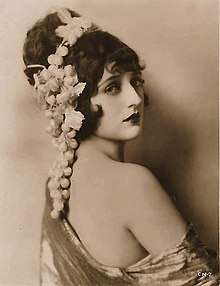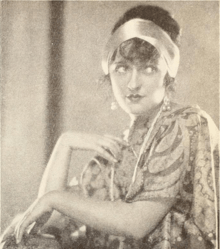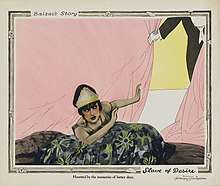Carmel Myers
Carmel Myers (April 4, 1899 – November 9, 1980) was an American actress who achieved her greatest successes in silent film.
Carmel Myers | |
|---|---|
 Myers, c. 1917 | |
| Born | April 4, 1899 San Francisco, California, U.S. |
| Died | November 9, 1980 (aged 81) Los Angeles, California, U.S. |
| Years active | 1915–1976 |
| Spouse(s) |
|
| Children | 3 |
Early life
Myers was born in San Francisco, the daughter of an Australian rabbi and an Austrian-Jewish mother.[1] Her father became well-connected with California's emerging film industry, and introduced her to film pioneer D. W. Griffith, who gave Carmel a small part in Intolerance (1916). Myers also got her brother Zion Myers into Hollywood as a writer/director.
Career
Silent film and theater
Myers left for New York City, where she acted mainly in theater for the next two years. She was signed by Universal, where she emerged as a popular actress in vamp roles. Her most popular film from this period—which does not feature her in a vamp role—is probably the romantic comedy All Night, opposite Rudolph Valentino, who was then a little-known actor. She also worked with him in A Society Sensation. By 1924, she was working for Metro-Goldwyn-Mayer, making such films as Broadway After Dark, which also starred Adolphe Menjou, Norma Shearer, and Anna Q. Nilsson.

In 1925, she appeared in arguably her most famous role, that of the Egyptian vamp Iras in Ben-Hur, who tries to seduce both Messala (Francis X. Bushman) and Ben-Hur himself (Ramón Novarro). This film was a boost to her career, and she appeared in major roles throughout the 1920s, including Tell It to the Marines in 1926 with Lon Chaney, Sr., William Haines, and Eleanor Boardman. Myers appeared in Four Walls and Dream of Love, both with Joan Crawford in 1928; and in The Show of Shows (1929), a showcase of popular contemporary film actors.
Sound films and television
Myers had a fairly successful sound career, mostly in supporting roles, perhaps due to her image as a vamp rather than as a sympathetic heroine. Subsequently, she began giving more attention to her private life following the birth of her son in May 1932. Amongst her popular sound films are Svengali (1931) and The Mad Genius (1931), both with John Barrymore and Marian Marsh, and a small role in 1944's The Conspirators, which featured Paul Henreid, Peter Lorre, and Sydney Greenstreet.
Myers surfaced in the entertainment world again briefly in 1951, with a short-lived DuMont Television Network show called The Carmel Myers Show, which followed the interview format. After its cancellation, Myers focused on a career in real estate and her own perfume distribution company. In 1976, Myers was one of the very few silent stars who were cast in Won Ton Ton, the Dog Who Saved Hollywood, a comedy featuring cameos by dozens of Hollywood stars of the past.
Personal life
Myers married Isidore "I.B." Kornblum in 1919; they divorced in 1923.[2][3]
Myers and attorney Ralph H. Blum married in 1929 and had three children: author Ralph H. Blum (b. 1932), known for his works on divination through Norse runes, and two adopted daughters, actress and radio personality Susan Adams Kennedy (b. 1940) and television producer Mary Cossette (b. 1941). Myers and Blum purchased Gloria Swanson's Sunset Boulevard home.
After Blum's death, Myers married Paramount Pictures executive Al Schwalberg.
Myers died in 1980 at the age of 81. She was buried near her parents at Home of Peace Cemetery in East Los Angeles.
Partial filmography





- Georgia Pearce (1915)
- Intolerance (1916) as Favorite of the Harem (uncredited)
- The Heiress at Coffee Dan's (1916) as Waitress (uncredited)
- The Bad Boy (1917) as Bit Role (uncredited)
- Stage Struck (1917) as Bit Role (uncredited)
- A Love Sublime (1917) as Toinette
- A Daughter of the Poor (1917) as Hazel Fleming
- Might and the Man (1917) as Winifred
- The Haunted Pajamas (1917) as Frances Kirkland
- Sirens of the Sea (1917) as Julie
- The Lash of Power (1917) as Marion Sherwood
- My Unmarried Wife (1918) as Mary Cunningham
- The Wife He Bought (1918) as Janice Brieson
- The Girl in the Dark (1918) as Lois Fox
- The Wine Girl (1918) as Bona
- The Marriage Lie (1918) as Eileen Orton
- A Broadway Scandal (1918) as Nenette Bisson
- The City of Tears (1918) as Rosa Carillo
- The Dream Lady (1918) as Rosamond Gilbert
- A Society Sensation (1918, short) as Sydney Parmelee
- All Night (1918) as Elizabeth Lane
- Who Will Marry Me? (1919) as Rosie Sanguinetti
- The Little White Savage (1919) as Minnie Lee
- In Folly's Trail (1920) as Lita O'Farrell
- The Gilded Dream (1920) as Leona
- Beautifully Trimmed (1920) as Norine Lawton
- The Mad Marriage (1921) as Jane Judd
- The Dangerous Moment (1921) as Sylvia Palprini
- Cheated Love (1921) as Sonya Schonema
- The Kiss (1921) as Erolinda Vargas
- Breaking Through (1921) as Bettina Lowden
- A Daughter of the Law (1921) as Nora Hayes
- The Love Gambler (1922) as Jean McClelland
- The Danger Point (1922) as Alice Torrance
- The Last Hour (1923) as Saidee McCall
- The Famous Mrs. Fair (1923) as Angy Brice
- Good-By Girls! (1923) as Florence Brown
- The Little Girl Next Door (1923) as Milly Amory
- Mary of the Movies (1923) as Herself (uncredited)
- Slave of Desire (1923) as Countess Fedora
- The Dancer of the Nile (1923) as Arvia
- The Love Pirate (1923) as Ruby Le Maar
- Reno (1923) as Mrs. Dora Carson Tappan
- Poisoned Paradise: The Forbidden Story of Monte Carlo (1924) as Mrs. Belmire
- Beau Brummel (1924) as Lady Hester Stanhope
- Broadway After Dark (1924) as Lenore Vance
- Babbitt (1924) as Tanis Judique
- Garragan (1924)
- Ben-Hur: A Tale of the Christ (1925) as Iras
- The Devil's Circus (1926) as Yonna
- The Gay Deceiver (1926) as Countess de Sano
- Tell It to the Marines (1926) as Zaya
- Camille (1926, short) as Agatha
- The Demi-Bride (1927) as Madame Girard
- The Understanding Heart (1927) as Kelcey Dale
- The Girl from Rio (1927) as Lola
- Sorrell and Son (1927) as Flo Palfrey
- A Certain Young Man (1928) as Mrs. Crutchley
- Prowlers of the Sea (1928) as Mercedes
- Four Walls (1928) as Bertha
- Dream of Love (1928) as The Countess
- The Ghost Talks (1929) as Marie Haley
- Careers (1929) as The Woman
- The Careless Age (1929) as Rayetta
- Broadway Scandals (1929) as Valeska
- The Show of Shows (1929) as Performer in 'Ladies of the Ensemble' Number
- The Ship from Shanghai (1930) as Viola Thorpe
- A Lady Surrenders (1930) as Sonia
- The Lion and the Lamb (1931) as Inez
- Svengali (1931) as Madame Honori
- Pleasure (1931) as Mrs. Dorothy Whitley
- Chinatown After Dark (1931) as Madame Ying Su
- The Mad Genius (1931) as Sonya Preskoya
- Nice Women (1931) as Dorothy Drew
- No Living Witness (1942) as Emillia
- The Countess of Monte Cristo (1934) as Flower Girl
- Lady for a Night (1942) as Mrs. Dickson
- The Conspirators (1944) as Baroness von Kluge (uncredited)
- George White's Scandals (1945) as Leslie (uncredited)
- Whistle Stop (1946) as Estelle
- Won Ton Ton, the Dog Who Saved Hollywood (1976) as Woman Journalist (final film role)
References
- Carmel Myers biography, filmography at Starpulse
- York, Cal (October 1923). "Gossip—East and West". Photoplay Magazine. Vol. 24 no. 5. p. 92.
- Oliver, Myrna (November 14, 1996). "I.B. Kornblum, 101; Composer, Lawyer and Union Organizer". Los Angeles Times.
External links
| Wikimedia Commons has media related to Carmel Myers. |
- Carmel Myers on IMDb
- Carmel Myers at the Internet Broadway Database
- Carmel Myers Photo Gallery at Silent-Movies.org
- Carmel Myers at Virtual History